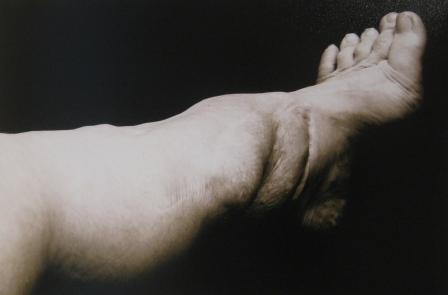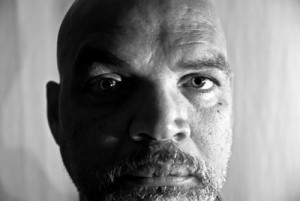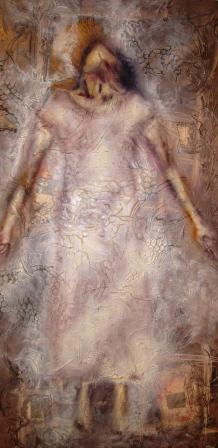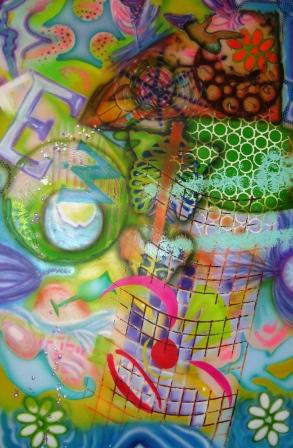Mirror Image
May 20th, 2010This article originally appeared on May 20, 2010 in The Island. Michele Ellson, editor.
Alameda Artists offer “Mirror Image”
Frisbie St. curators Becky Jaffe, Lanell Dike, and Carrie-Andrea Kaye have put together a show with remarkable depth and breadth, including the work of two dozen artists. I had the opportunity to preview it, and be forewarned: “Mirror Image” – which features two artists with Alameda connections – is crazy intense. Demons are not willingly exorcised, and whether yours involves food or its rejection, age or illness, injury or self-injury, whether you are a man or woman, straight, gay, bisexual or transgender, there is something to push nearly everyone’s emotional buttons.

“Left Leg Medial View” by Mercy Calman
Mercy Calman, who lives in Alameda, is known for her brightly colored photographs of plants illuminated by natural light. She had participated in the previous two shows at Oakland’s Frisbie St. and, wanting to continue exhibiting there, faced a daunting challenge: Photograph a human.
She didn’t have to go far to find her subject, photographing her own leg, which was seriously injured in a motorcycle accident. She provides three uncharacteristically black & white images. In the two on the periphery she is standing on palm bark, one foot tucked coyly behind the other. She is Imogen’s Twinka in Yosemite. But in the large centerpiece — “Left Leg Medial View” (she’s also an RN) — her leg is gloriously extended in all its “imperfect” glory.
Apparently lit by a simple flash, the light and shadow, textures, and composition are exquisite. It’s Diane Arbus meets Edward Weston, and this synecdochical self-portrait is among the finest work in the exhibit.
Bruce Temuchin Brown prefers to remain mum on how he creates his silver halide on copper plate photographs, which is entirely unnecessary; even if we knew his exact process it’s doubtful that many could have produced “Maxine.” Viewing this nude photograph of an older, white-haired woman, I didn’t notice that she had had a mastectomy until a curator pointed it out. Did I miss that because of the irregularities in the copper’s surface? Was I trying to maintain respectful eye contact with the model (although she is looking away)? Or was I afraid to look at her body because of her age? Perhaps in this dismissing of her body lies the need to “come to terms” with aging.
There are several multimedia installations, including a collection of photos and recorded interviews by Becky Jaffe. These cover such personal battles as learning to accept one’s body again while dealing with the side-effects of HIV medication. Another describes the fear of obesity after his young father’s heart attack, while exhorting others to accept themselves as they are. He proclaims, “Maybe your body is deteriorating. Embrace it! Maybe you’re overweight. Embrace it!” The models in this and all other exhibited works were invited to attend the opening, and encouraged to provide a statement of their own.

Jon: “I carry the weight of your fears,” from Elisa Salasin’s “You Carry Your Weight Well”
Another is Elisa Salasin’s “You Carry Your Weight Well.” A slideshow of images, mostly self-portraits, they bear captions like “I carry the weight of making everything perfect,” “I carry the weight of the inextricable tangle of love and loss,” and “I carry the weight of protecting my family.” Salasin hopes that some who view the exhibit at its opening will be inspired to contribute their own photos and text to be included for the remainder of its three-day run.
Several pieces will no doubt provoke discussion, possibly controversy. Two of these are G.M.M. Coghlan’s series on cutting, and Gary Wilson’s “Yada Yada Warden.” When I first saw them I loved the former. The latter … not so much. By the next morning my opinions of them had swapped.
Wilson’s “Yada Yada Warden” is a hammer supported by twin pieces of wood giving it the swagger of a bowlegged cowboy. He has affixed a tongue to the hammer’s head and, to the tail, a parody of male genitals, complete with balls of steel. To me it represented sexual imperialism, male entitlement, perhaps even rape. However, this “kinetic shamanic totem” was intended as a tribute to Lenny Bruce’s relentless hammering away against censorship. (Its title comes from a Lenny Bruce routine.) And perhaps the way he distilled Bruce down to those “essentials” reflects the way all men are summarized and objectified: A handyman. A turkey baster. The sculpture is wedged between Frank King’s large format photos of a muscular, faceless man — “Humiliation” and “Without Consent” — bound by rope, and perhaps “muscle bound,” trapped by his own masculinity. Together they make a provocative statement, regardless of how you read them.
Coghlan’s series of photos of “cutters” was created for a project about fashion paraphernalia, and was intended to symbolize the extent to which people damage their bodies in the name of fashion and beauty. The photos packed an emotional wallop that sent me reeling. Literally. Only after I had recovered, sometime the next day, did I feel like I had been sucker punched. These photos were staged, the model bleeding the same Hershey’s chocolate syrup that coursed through Janet Leigh’s veins in “Psycho.” Moreover, the internal psychological mechanism behind self-injury is far removed from the external pressures behind foot binding, corseting, plastic surgery, and high heels. It is an interesting and well-intentioned but mixed metaphor which ultimately rings false.

“Visitation” by Maia Huang
Coghlan chose not to photograph actual cutters because he didn’t want to support that behavior. But is photographing a person with anorexia, for example, “encouraging her,” or does it extend a measure of detachment and objectivity which may help her to understand the misperception of her body?
The curators wrote in their statement, “We invite you to think critically, to debate, to listen, to change your mind….” So I changed my mind. And just maybe I need to lighten up a little bit.
Not all body image perceptions come from visible attributes. Maia Huang has two hidden disabilities, fibromyalgia and Crohn’s disease. She writes in her statement, “My relationship to my body is a complicated one. On the one hand, I feel comfortable with the outward appearance of my body. I like the shape and physical features I’ve been endowed with. However, inside is a different story.” Huang believes that this has led to her career as an expressive arts therapist. Her mixed media painting, “Visitation,” portrays “a visitation with the divine, in a Christ-like pose of shared suffering and transcendence.”

“Skeletrol” by Matthew Kowalski
Matthew Kowalski is a member of the Alameda Art Association and his work can also be found at their Alameda Towne Centre gallery. His inclusion in “Mirror Image” stems from his own invisible affliction: Homeless for 25 years, Kowalski felt that no one could see him, that he had “no face, no body that was acknowledged or validated.” However, his art was visible and acted as his “body image.” His “Radical Relief” abstract paintings intentionally rely upon found objects applied in print making as his contribution to reuse and repurposing. They are an expression of his positive self-image, and are the most emotionally as well as visually upbeat work in the show.
Frisbie St. is located at 204 Frisbie Street in Oakland. “Mirror Image” opens Friday, May 21, with a reception from 6 p.m. to 9 p.m. The exhibit continues on Saturday, May 22 from 2 p.m. to 9 p.m., and the closing reception is on Sunday, May 23, from 1 p.m. to 5 p.m.
Michael Singman-Aste
Postdiluvian Photo
Tags: Becky Jaffe, Bruce Temuchin Brown, Carrel Crawford, Carrie-Andrea Kaye, CJ Grossman, Courtney McCutcheon, cutting, Deanne Emmons, Elisa Salasin, Evert Grobbelaar, Frank King, Frisbie St., G.M.M. Coghlan, Gary Wilson, JJ Fryzel, Lanell Dike, Lauren Davis, Linda Shanti McCabe, Maia Huang, Matthew Kowalski, Mercy Calman, Michael Slack, Mollee Weaver, Molly Kate Taylor, Myles Boisen, Oakland, Scott D.S. Young



You must be logged in to post a comment.